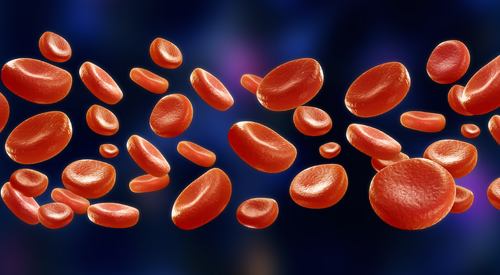Talazoparib Plus Enzalutamide Significantly Improves PFS in Patients With HRR mCRPC
Talazoparib reduced the risk of progression or death by 55% in patients with metastatic castration-resistant prostate cancer and homologous recombination repair gene alterations.
Karim Fizazi, MD

The addition of talazoparib (Talzenna) to enzalutamide (Xtandi) was associated with statistically significant and clinically meaningful improvement in radiographic progression-free survival (rPFS) in patients with metastatic castration-resistant prostate cancer (mCRPC) that have homologous recombination repair (HRR) gene alterations. These findings were simultaneously presented at the 2023 American Society of Clinical Oncology (ASCO) Annual Meeting and published in The Lancet.1,2
These data were part of the randomized, double blind, phase 3 TALAPRO-2 study (NCT03395197), which marked the first phase 3 study to compare the combination of the poly(ADP-ribose) polymerase inhibitor talazoparib and androgen receptor enzalutamide compared with placebo and enzalutamide.
The TALAPRO-2 study reached its primary end point of rPFS with a 55% reduced risk of progression of death in patients on the combination arm (n = 200), even though the median rPFS was not reached (NR) in the talazoparib arm (95% CI, 21.9-NR) compared with 13.8 months (95% CI, 11.0-16.7) in the placebo arm (HR, 0.45; 95% CI, 0.33-0.61; P < .0001). Moreover, the combination resulted in a 37% lower risk of rPFS in the combination arm compared with the placebo and enzalutamide arm (HR, 0.63; 95% CI 0.51–0.78; P < .0001).
According to Karim Fizazi, MD, who presented these data at the ASCO meeting, rPFS benefit extended to all subgroups of HRR deficient patients on the trial (HR, 0.44; 95% CI, 0.32-0.60, P < .0001), but importantly also for patients who had a BRCA alteration in their disease. Overall, patients with BRCA alterations in general had a greater benefit in the talazoparib and enzalutamide arm (HR, 0.20; 95% CI, 0.11-0.36; P < .0001) compared with patients with non-BRCA alterations on the combination as well (HR, 0.68; 95% CI, 0.46-1.02; P = .060). Patients with a BRCA alteration had an approximately 80% reduction in risk of death and disease progression compared to patients with non-BRCA.
In the baseline of patients on the trial, those with a BRCA2 alteration in their disease made up 31% of patients in the combination arm compared with 36.7% in the placebo arm, whereas patients with a BRCA1 alteration made up 5.5% and 6%, respectively. HRR deficient patients with only a BRCA2 alteration (n = 55) in the combination arm still had a significant rPFS compared to the BRCA2 patients (n = 60) on the placebo arm (HR, 0.19; 95% CI, 0.10-0.38; P < .0001). Similar results were seen with patients who had only a BRCA1 alteration (HR, 0.17; 95% CI, 0.02-1.51; P = .074) and significant rPFS benefit was seen in patients with a BRCA cluster in their disease (HR, 0.20; 95% CI, 0.11-0.36; P < .0001).
“It’s [also] important to mention that men who had prior abiraterone, or docetaxel for castration sensitive disease, tend to benefit quite the same as compared to those who did not receive these agents, with a hazard ratio of approximately 0.45,” Fizazi added, a medical oncologist at Gustave Roussy and professor of oncology at the University of Paris-Saclay in France.
Patients given prior abiraterone or docetaxel made up 37.5% of patients in the combination arm compared with a similar rate in the placebo arm at 37.2%. More patients in the combination arm and placebo arm had just docetaxel vs abiraterone at 8% vs 30.2% and 8% vs 28.5%, respectively. Overall, most patients’ disease was in the bone in both arms at 87.5% in the talazoparib arm and 79.4% in the placebo arm, with a similar median range of prostate specific antigen (PSA) at 19.6 ng/mL (range, 0.2-3412.0) in the talzoparib arm compared with 18.0 ng/mL (range, 0.0-1055.0) in the placebo and enzalutamide arm.
The combination of talzoparib with first-line enzalutamide also prolonged the time to PSA progression for these mCRPC patients, which according to Fizazi, was a dramatic improvement of approximately 40% reduction of risk between both arms. A median of 28.6 months (95% CI, 26.7-NR) time to PSA progression in the treatment arm was seen compared with 11.1 months (95% CI, 9.3-13.9) in the placebo and enzalutamide arm (HR, 0.41; 95% CI, 0.30-0.57, P < .0001).
These results extended to improving the time to cytotoxic chemotherapy at 38 events in the combination arm vs 65 in the placebo arm (HR, 0.46; 95% CI, 0.31-0.79; P = .0001) and a median PFS2 of 36.4 months (95 CI, 364.4-NR) and 28.1 months (95% CI, 24.5-NR), respectively (HR, 0.57; 95% CI, 0.39-0.85; P = .0045).
An objective response rate (ORR) of 67.1% was observed in the combination arm, with 38.4% of those responses being complete responses. The stable disease rate was of 26% and 5.6% of the remaining patients on the combination arm had progressive disease. In comparison, the ORR was 40% in the placebo arm with 18.5% of those responses being complete, 32.3% had stable disease and 20% had progressive disease.
Ultimately, no new safety signals were identified with the combination regimen, but grade 3-4 treatment emergent adverse effects (TEAEs) made were seen in 66.2% of patients on the combination therapy vs 37.2% of those on the placebo and enzalutamide treatment. Dose interruption of talazoparib due to an adverse effect (AE) was seen in 67.2% of patients compared with 19.6% of those on the placebo arm and just over half of patients (55.6%) in the combination arm had to dose reduce their talazoparib.
Still, discontinuation rates were low in the combination arm at 10.1% compared with 7% in the placebo arm, and AEs of interest with talazoparib remained low with no reported cases of myelodysplastic syndrome or acute myeloid leukemia. Fizazi also highlighted that the use of talazoparib and enzalutamide prolonged the time to a clinically meaningful deterioration of quality of life at a median of 27.1 months (95% CI, 21.2-NR) compared with 19.3 months (95% CI, 16.6-23) in the placebo arm (HR, 0.69; 95% CI, 0.49-0.97; P = .032).
“Based on these data, I believe that talazoparib plus enzalutamide, if approved, should become a standard of care for patients with mCRPC [with] HRR alterations, [and] mostly those with BRCA alterations,” Fizazi concluded.
References
- Fizazi K, Azad A, Matsubara N, et al. TALAPRO-2: Phase 3 study of talazoparib (TALA) + enzalutamide (ENZA) versus placebo (PBO) + ENZA as first-line (1L) treatment for patients (pts) with metastatic castration-resistant prostate cancer (mCRPC) harboring homologous recombination repair (HRR) gene alterations. J Clin Oncol. 2023;41(suppl 16):5004. doi:10.1200/JCO.2023.41.16_suppl.5004
- Agarwal N, Azad A, Carles J, et al. Talazoparib plus enzalutamide in men with first-line metastatic castration-resistant prostate cancer (TALAPRO-2): a randomised, placebo-controlled, phase 3 trial. Lancet. Published online June 2, 2023. doi:10.1016/S0140-6736(23)01055-3
Trajectory of Symptom Severity Aids Follow-Up in Head and Neck Cancer Treatment
April 27th 2024As symptom severity can vary by patient, it is key for nurses to increase assessment for early intervention of patients with head and neck cancer following treatment, according to Meredith Cummings, PhD(c), BSN, RN, OCN.




